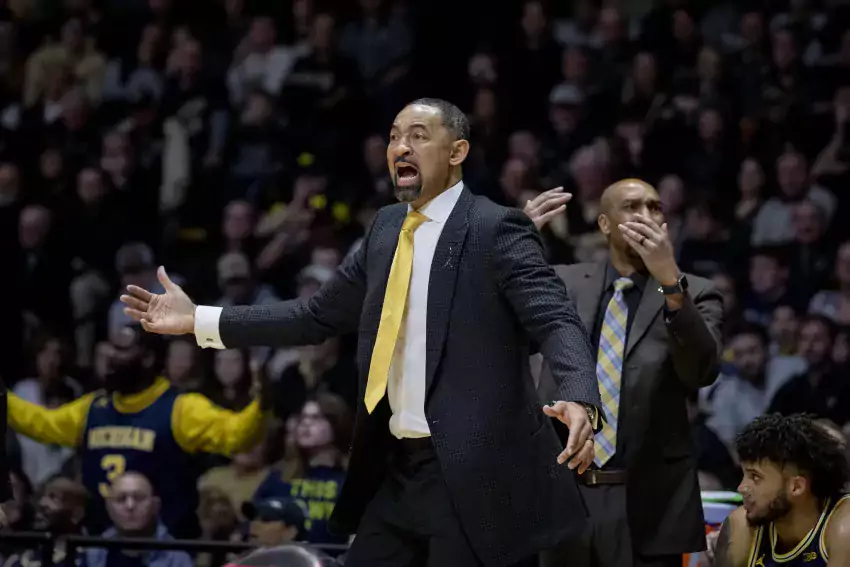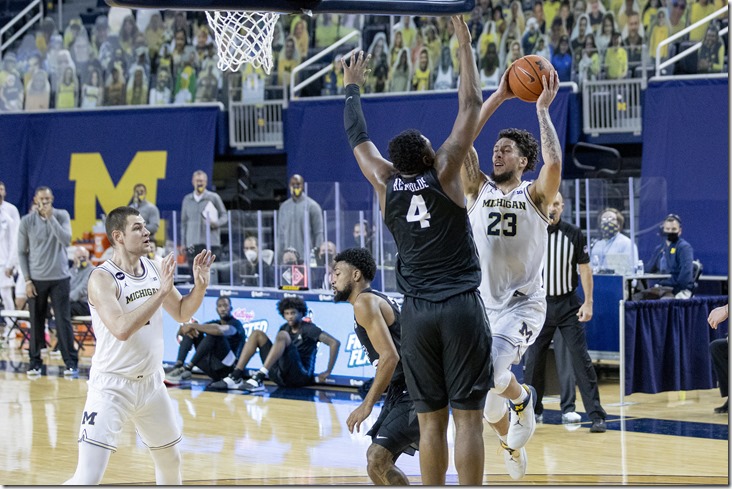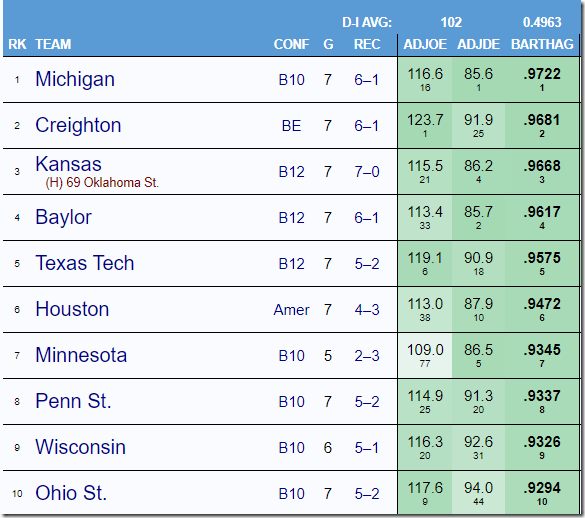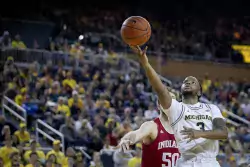juwan howard ref face

12/6/2020 – Michigan 80, Central Florida 58 – 4-0
The first thing Terrance Williams did when he came in the game was run half a guy over and score. Michigan went on a 22-5 run immediately after his insertion.
Brandon Johns also came in at about the same time. Johns ended up a free throw away from an inverse trillion: he had something in every other column of a box score (1/1 from two, 1/2 from 3, an OREB, a DREB, two assists, a turnover, a block, a steal, and four fouls). At one point he dove in from the perimeter and ended up dumping a ball off to Hunter Dickinson from an angle that looked impossible until the moment it opened up.
use the force Johns [Campredon]
Then
I love how happy he is on the court. It’s like he escaped from Shawshank
— Scratch BBQ and Catering (@ScratchBbq) December 6, 2020
Isaiah Livers didn't score until he got a putback with six minutes left. Michigan was up 26.
----------------------------------------------------
If you've been reading this site for at least a year you probably remember that Michigan melted without Isaiah Livers last year. We spent big chunks of the season slicing Bart Torvik's rankings into with and without Livers ribbons to demonstrate how indispensable he was to the operation. After he returned Michigan's three point luck went from horrendous to good and Michigan stormed through February, finishing as the #1 team in the country for the month.
This team is not going to melt if Livers isn't available, or is having a bad game.
This edition of Michigan has a lot of questions yet to be answered but we just got one about depth against a reasonably good team coming off a win against Auburn. Minus their established leader and projected breakout player, Michigan clawed back a 12-point deficit, and by the time that leader got on the board they'd turned a close game into a laugher.
There is a player that they'd melt without—Hunter Dickinson, about whom more in a minute—but last year it felt like virtually any player exiting for an extended period would result in a severely compromised team. This time around guys can emerge from the bench, thump dudes for a quarter of the game, and get a hat that says I PLAYED IN THE FIRST HALF upon return to the bench. That's going to be extremely valuable with a compressed schedule and COVID chaos on the horizon.
[After the JUMP: plus minus is useful at the extremes, and we've got extremes]

Let's dive back in to more of your questions, starting with what makes for a successful coach.
Hi Ace,
Curious on your thoughts on what the most important aspects to being a great college coach are (e.g. 40% recruiting/roster management, 30% team management, 20% PR/face of program, 10% scheme/Xs-and-Os, etc), and how you'd grade Howard's first season along those lines, as well as a prognosis going forward.
Best,
Mike
I'll preface with this: there's a lot more than one way to be a highly successful college coach. Recruiting at a high level can cover for shortcomings as a strategist. A strong player development program can make up for recruiting lesser talent than your peers. John Beilein and Larry Brown have (officially) made the same number of Final Fours. Same goes for Bill Self and Jay Wright. These coaches aren't similar in on- or off-court approach but they've fit at their respective schools, which is arguably the most important factor.
If I had to break it down into categories, they'd be: fit with school/administration, recruiting/image, roster management, player development, scheme, and game management. While an elite college coach doesn't have to be great at every one of these factors, they usually check off most of the boxes.
It's early yet to be able to judge Juwan Howard on some of these. A quick stab at grades:
Fit with school/administration: A. I'm assuming the readers of this post are familiar with Juwan Howard, former All-American at Michigan, basketball lifer, and universally regarded good dude. It's hard to overstate how fortunate the program was that such a tight fit was available despite the late timing of John Beilein's departure.
Recruiting/image: A. Howard is the face of the program, his first recruiting class ranks fourth in the country, and he could still add a second five-star to that group. This moves up to an A+ if Josh Christopher commits—it'd be difficult to imagine a better start after Howard had to hit the ground running with a 2020 class that needed more commits than usual.
Roster management: Incomplete. We'll learn more about Howard's ability to juggle a roster this offseason. He appears prepared for unexpected attrition with Michigan's pursuit of multiple grad transfer point guards even though the team is full for the moment after scratching Austin Davis and Adrien Nunez off the potential attrition list.
Beilein learned the hard way that great programs lose players at a steady rate to both the NBA and programs where even established rotation players can find more playing time; it took him a while to adjust and he still got caught off-guard by last year's early entry decisions by Jordan Poole and Iggy Brazdeikis. Howard seems to know how the game is played and his experience as both a former elite player and the father of high-level prospects should serve him well.
Player development: Incomplete. The unexpected breakout of Austin Davis indicates Howard at least should be good at getting the most out of his big men. That said, it's way too early to put a grade on his player development. This is something to revisit a year or three down the road.
Scheme: B+. I really like the framework. Howard didn't stand pat with John Beilein's offense despite having his pick-and-roll duo as seniors, instead building around the ball screen offense with plenty of NBA sets and added wrinkles. The defensive philosophy was also clear: play man defense with the occasional zone changeup (almost always after a timeout), use drop pick-and-roll coverage when possible, run shooters off the arc, and force players to beat you one-on-one.
I need to see more to move the grade any higher, especially since he could build so much off the Simpson/Teske pick-and-roll—we'll get a clearer view of how Howard wants to operate as he molds the roster to his preference instead of working with another coach's players.
Game management: B-. The area I most want to see improvement. Howard made some strange lineup decisions during the season that were usually borne of his strong adherence to the hated autobench policy. His best schematic adjustments often came either between games against the same opponent (see: hedging Cassius Winston and leaving Xavier Tillman to shoot in the second MSU game) or too late in the game to alter the outcome (see: playing Brandon Johns at center against Wisconsin).
I wouldn't say Howard was bad at game management by any stretch. He had to work within some serious limitations when Franz Wagner and Isaiah Livers were absent for significant stretches of time. He utilized timeouts well on both ends, drawing up effective plays and using that zone changeup to flummox offenses running a set to beat man. I would've loved to see him in a postseason tournament setting this year. Alas.
[Hit THE JUMP for what I'm missing most about the tournament, what next year's offense could look like, and more.]

2/22/2020 – Michigan 71, Purdue 63 – 18-9, 9-7 Big Ten
Back in November, Michigan lost a game at Illinois in which they shot 3/18 from three. I surveyed Michigan's available roster, which was a bunch six-foot guards, a beanpole freshman, a guy Juwan Howard describes as a "big guard" playing the four, and Jon Teske, and decided that this was not a team that was going to overcome that kind of brickfest:
3/18 from three, the end
— mgoblog (@mgoblog) December 12, 2019
It is late February and Michigan has won consecutive road games against teams close to the NCAA cutline. They shot 6/23 from three in one, 6/25 in the other. In this one Zavier Simpson was 0/10 from the floor. Michigan shot 24% from three; their star point guard didn't score until Eat Your Liver Time; Michigan led by about 15 points most of the second half. The Aristocrats!
Avid Torvik slicers are all over the internet telling anyone who will listen that Michigan is college basketball's best team in the month of February. It's true.
2-3 Minnesota is in there on the back of a blowout of Northwestern, so grain of salt and all that. But Michigan's vaunted defense has returned after a troubling midseason lull. That rebound allows Michigan to go on the road and clank a bunch of shots and win games.
Hit some damn shots and there's nobody in the country save maybe Kansas and Baylor who's coming out unscathed.
The turnaround in four numbers. Michigan from behind the line in January:
- OFFENSE: 26.8%, #329 nationally
- DEFENSE: 40.2%, #341 nationally
In February:
- OFFENSE: 35.6%, #94 nationally
- DEFENSE: 25.8%, #19 nationally
On the season Michigan is #105 on O and #44 on D. The January numbers were ludicrously unlucky; the February numbers are probably a little kind but are much closer to Michigan's season-long performance levels. Having Livers for big chunks of February helps, and further points towards this being the Real Michigan.
[After THE JUMP: T-Minus some number for Franz liftoff.]



22